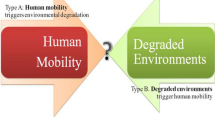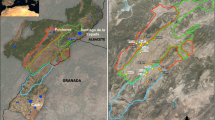Abstract
Rattan cane is an important non-timber forest product (NTFP) harvested from Indonesian tropical forests. However, the extraction of NTFPs such as rattan cane may conflict with forest conservation efforts. A better understanding of harvesting practices can help assess the extent of this conflict and guide forest management decisions. This study assesses the accessibility factors that influence rattan cane harvesting levels in Lambusango Forest, Buton Island, Indonesia, and whether the harvesting of rattan cane is affected by the designation of conservation areas. To this end, the analysis adopts participatory mapping, Geographic Information Systems and a questionnaire survey and employs multiple regressions and analysis of covariance. The results show that accessibility, particularly slope and distance, can play a role in the quantity of rattan canes harvested. The presence of conservation forest does not significantly affect rattan cane harvesting levels. This could be due to limited awareness of the harvesters going to the vicinity of the designated conservation areas and mixed sentiments towards conservation efforts due to the long tradition of forest dwelling and harvesting activities. The study concludes that the successful establishment and management of conservation areas require consideration of the specificity of the local context such as the abundance of forest resources, accessibility and historical forest-people interactions, in addition to biological factors.









Similar content being viewed by others
Notes
In forest conservation, participatory mapping and participatory GIS has the potential to be combined with resource monitoring by the community to improve understanding of the abundance or scarcity of harvested resources (Bawa et al. 2007) among researchers and the community themselves (Kalibo and Medley 2007; Mbile et al. 2005). It also has the scope to enable ‘countermaps’ to be produced which display the needs and requirements of the groups who are usually excluded from scientific surveys because they are socially and institutionally marginalized (McCall 2003, cited by Sun et al. 2009).
This is likely to be because the village head felt that there was insufficient remuneration for involvement in activities that an NGO had instigated to promote conservation in the area. The first author was loosely affiliated with this NGO during her fieldwork activity
Consultative participation is described as being asked an opinion in specific matters without guarantee of influencing decisions and activity specific participation is being asked (or volunteering to) undertake specific tasks (Agrawal 2001).
The reason for this was that in some areas rattan harvesters have been, or have heard about people being prosecuted for illegal logging and feared a similar fate
Reopened in 2006.
References
Abbot, J., Chambers, R., Dunn, C., Harris, T., Merode, E., Porter, G., Townsend, J., and Weiner, D. (1998). Participatory GIS: Opportunity or Oxymoron. PLA Notes Durham, UK, pp. 27–33.
Agrawal, B. (2001). Participatory Exclusions, Community Forestry and Gender: An Analysis for South Asia and a Conceptual Framework. World Development 29(10): 1623–1648.
Ambrose-Oji, B. (2003). The Contribution of NTFPs to the Livelihoods of the ‘Forest Poor’: Evidence from the Tropical Forest Zone of South-West Cameroon. International Forestry Review 5(2): 106–117.
Arnold, J. E. M., and Ruiz Perez, M. (2001). Can Non-Timber Forest Products Match Tropical Forest Conservation and Development Objectives? Ecological Economics 39: 437–447.
Bakosurtanal (Badan Koordinasi dan Pemetaan Nasional) (1989). Peta Rupabumi Indonesia skala 1:50,000
Bawa, K. S., Joseph, G., and Setty, S. (2007). Poverty, Biodiversity and Institutions in Forest-Agriculture Ecotones in the Western Ghats and Eastern Himalaya Ranges of India. Agriculture, Ecosystems & Environment 121: 287–295.
Chambers, R. (2006). Participatory Mapping and Geographic Information Systems: Whose Map? Who is Empowered and Who is Disempowered? Who Gains and Who loses? EJISDC 25(2): 1–11.
Direktorat Jendral PHKA. (2008). Available at: http://www.ditjenphka.go.id/index.php?a=km, (Last accessed: 18 November 2008)
DSS (Data and Statistical Services)—Princeton University (2007). Available at: http://dss.princeton.edu/online_help/analysis/regression_intro.htm (Last accessed: 31 March 2009)
Dovie, D. B. K. (2003). Whose Involvement?—Can Hierarchical Valuation Scheme Intercede for Participatory Methods for Evaluating Secondary Forest Resource Use? Forest Policy and Economics 5: 265–283.
Dransfield, J., and Manokaran, N. (1994). Plant Resources of Southeast Asia 6. Rattans, Prosea.
Duvail, S., Hamerlynk, O., Nandi, R., Mwambeso, P., and Elibariki, R. (2006). Participatory Mapping for Local Management of Natural Resources in Villages of the Rufiji District (Tanzania). EJISDC 25(6): 1–6.
ESRI (1999) Hydrological modelling—watershed request. In. Environmental Systems Resarch Institute
Gross, D. R. (1984). Time Allocation: A Tool for the Study of Cultural Behavior. Annual Review of Anthropology 13: 519–58.
Gubbi, S., and MacMillan, D. C. (2008). Can Non-Timber Forest Products Solve Livelihood Problems? A Case Study from Periyar Tiger Reserve, India. Oryx 42: 222–228.
Gunatilake, H. M., Senaratne, D. M. A. H., and Abeygunawardena, P. (1993). Role of Non-Timber Forest Products in The Economy of Peripheral Communities of Knuckles National Wilderness Area of Sri Lanka: A Farming Systems Approach. Economic Botany 47(3): 275–281.
IFAD (2009). Good practices in participatory mapping, International Fund for Agricultural Development. Available at http://www.ifad.org/pub/map/PM_web.pdf (last accessed 3 rd March 2010)
Jankowski, P. (2009). Towards Participatory Geographic Information Systems for Community Based Environmental Decision-Making. Journal of Environmental Management 90: 1966–1971.
Kaimowitz, D., and Angelsen, A. (1998). Economic Models of Tropical Deforestation: A Review. CIFOR, Bogor. 153 pp.
Kaimowitz, D., and Sheil, D. (2007). Conserving What and for Whom? Why Conservation Should Help Meet Basic Human Needs in the Tropics. Biotropica 39(5): 567–574.
Kalibo, H. W., and Medley, K. E. (2007). Participatory Resource Mapping for Adaptive Collaborative Management at Mt. Kasigau, Kenya. Landscape and Urban Planning 82: 145–158.
Kusters, K., Achdiawan, R., Belcher, B., and Ruiz Pérez, M. (2006). Balancing Development and Conservation? An Assessment of Livelihood and Environmental Outcomes of Non Timber Forest Product Trade in Asia, Africa, and Latin America. Ecology and Society 11(2): 20.
Malleson, R. (2005). Socio-Economic Baseline Surveys of Communities Bordering the Lambusango Forest, South East Sulawesi, Indonesia, Report No. 1 to Operation Wallacea Trust Lambusango Forest Conservation Project. LFCP, Bau Bau
Malleson, R., Asaha, S., Sunderland, T., Burnham, P., Egot, M., Obeng-Okrah, K., Ukpe, I., and Miles, W. (2008). A Methodology for Assessing Rural Livelihood Strategies in West/Central Africa: Lessons from the Field. Ecological and Environmental Anthropology 4(1): 1–12.
Marcoulides, G. A., and Hershberger, S. L. (1997). Multivariate Statistical Methods: A First Course. Lawrence Erlbaum Associates, New Jersey. 322 pp.
Masozera, M. K., and Alavalapati, J. R. R. (2004). Forest Dependency and its Implications for Protected Areas Management: A Case Study from the Nyungwe Forest Reserve, Rwanda. Scandinavian Journal of Forest Research 19: 85–92.
Mbile, P., Vabi, M., Meboka, M., Okon, D., Arrey-Mbo, J., Nkongho, F., and Ebong, E. (2005). Linking Management and Livelihood in Environmental Conservation: Case of the Korup National Park, Cameroon. Journal of Environmental Management 76(1): 1–13.
McCall, M. (2006). Precision for whom? Mapping ambiguity and certainty in (Participatory) GIS, Participatory Learning Action, pp. 114–119.
NASA Landsat Program (2006). Landsat TM. USGS, Sioux Falls.
NBSAP (2004). National Biodiversity Strategy to 2020 and Action Plan to 2010, Lao PDR, Prime Minister’s Office, Science, Technology and Environment Agency, No 1066/STEA-PMO, Vientiane, 3 rd June 2004
Ndangalasi, H. J., Bitariho, R., and Dovie, D. B. K. (2007). Harvesting of Non-Timber Forest Products and Implications for Conservation in Two Montane Forests of East Africa. Biological Conservation 134(2): 242–250.
Olupot, W., Barigyira, R., and Chapman, C. A. (2009). The Status of Anthropogenic Threat at the People-Park Interface of Bwindi Impenetrable National Park, Uganda. Environmental Conservation 36: 41–50.
Palmer, B. (2004). Memories of Migration: Butonese Migrants returning to Buton after the Maluku conflicts 1999–2002. Antropologi Indonesia, Special Volume
Paumgarten, F. (2006). The Role of Non-Timber Forest Products as Safety-Nets: A Review of Evidence with a Focus on South Africa. GeoJournal 64: 189–197.
Peters, C. M., Gentry, A. H., and Mendelsohn, R. O. (1989). Valuation of an Amazonian Rainforest. Nature 339: 655–656.
Powling, A. (2009). The palms of Buton, Indonesia, an island in Wallacea. Palms 52, in press
President of the Republic of Indonesia. (1990). Undang Undang no 5/1990
Purwanto, E. (2005a). 4th Progress and Implementation Plan Report, Lambusango Forest Conservation Project, South East Sulawesi. LFCP, Bau Bau.
Purwanto, E. (2005b). 5th Progress and Implementation Plan Report, Lambusango Forest Conservation Project, South East Sulawesi. LFCP, Bau Bau.
Purwanto, E. (2008). Lambusango Forest Conservation Project, South East Sulawesi, Indonesia—Progress, Achievements, Lessons Learned and Outlook (June 2005–February 2008). LFCP, Bau Bau.
Osly Rachman, J. (2006). Rotan-Sumberdaya, Sifat dan Pengolahannya. Badan Penelitian dan Pengembangan Kehutanan, Departemen Kehutanan, Bogor.
Rambaldi, G., Chambers, R., Mccall, M. and Fox, J. (2006). Practical ethics for PGIS practitioners, facilitators, technology intermediaries and researchers, Participatory Learning and Action, pp. 106–113. Available at: http://www.iapad.org/publications/ppgis/ch14_rambaldi_pp106-113.pdf (last accessed: 31 March 2009)
Rigg, J. (2009). A particular place ? Laos and its incorporation into development mainstream. Environment and Planning A 41: 703–721.
Sarantakos, S. (2005). Social Research. Palgrave Macmillan, New York. 464 pp.
Schäuble, H. (2008). HydroTools 1.0 for ArcView 3.x 2004. Available from http://www.terracs.de/ (last accessed: 31 March 2009).
Seymour, A. (2006). Summary of Biological and Sociological Research Carried Out by Operation Wallacea in The Forest of Central Buton. Operation Wallacea-Indonesia Programme, Jakarta.
Shaanker, R. U., Ganeshaiah, K. N., Krishnan, S., Ramya, R., Meera, C., Aravind, N. A., Kumar, A., Rao, D., Vanraj, G., Ramachandra, J., Gauthier, R., Ghazoul, J., Poole, N., and Chinnappa Reddy, B. V. (2003). Livelihood gains and ecological costs of NTFP dependence: assessing the roles of dependence, ecological knowledge and market structure in three contrasting human and ecological settings in South India. The International Conference on Rural Livelihoods, Forests and Biodiversity, Bonn.
Siebert, S. F. (2001). Tree Cutting to Float Rattan to Market: A Threat to Primary Forests? Journal of Bamboo and Rattan 1(1): 37–42.
Siebert, S. F. (2004). Demographic Effects of Collecting Rattan Cane and Their Implications for Sustainable Harvesting. Conservation Biology 18(2): 424–431.
Stockdale, M. (2005). Steps to Sustainable and Community-Based NTFP Management: A Manual Written with Special Reference to South and Southeast Asia. NTFP Exchange Programme for South and Southeast Asia, Quezon City.
Sun, M. T.-W., Tsai, Y.-T., Shih, M.-C., and Lin, J. Y.-W. (2009). Public participation and the concept of space in environmental governance: An application of PPGIS. Public Administration and Development 29: 250–261.
Sunderland, T. C. H. and Dransfield, J. (2002). Species profiles of rattans, Rattan: Current Research Issues and Prospects for Conservation and Sustainable Development. Non-Wood Forest Products—14 FAO, Rome.
Tripathi, N., and Bhattarya, S. (2004). Integrating Indigenous Knowledge and GIS for Participatory Natural Resource Management: State-of-the-Practice. EJISDC 17(3): 1–13.
VSO (2004). Participatory Approaches: A facilitator’s guide. Voluntary Service Overseas, London.
Whitten, T., Henderson, G. S. and Mustafa, M. (2002). The Ecology of Sulawesi. Periplus.
Acknowledgments
The wider project at Lambusango Forest was funded by the World Bank’s Global Environment Fund through the Operation Wallacea Trust-Lambusango Forest Conservation Programme. Activities specifically conducted for this study were funded by the International Foundation of Science (IFS) and logistics provision during field work was also supported by Operation Wallacea-Indonesia Programme. Input and feedback on this paper from Dr Edi Purwanto and Dr Michael Jeffries are appreciated. The authors would like to thank the two anonymous reviewers for their constructive comments.
Author information
Authors and Affiliations
Corresponding author
Rights and permissions
About this article
Cite this article
Widayati, A., Jones, S. & Carlisle, B. Accessibility Factors and Conservation Forest Designation Affecting Rattan Cane Harvesting in Lambusango Forest, Buton, Indonesia. Hum Ecol 38, 731–746 (2010). https://doi.org/10.1007/s10745-010-9358-7
Published:
Issue Date:
DOI: https://doi.org/10.1007/s10745-010-9358-7




